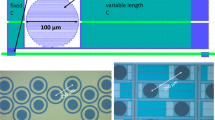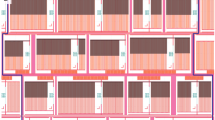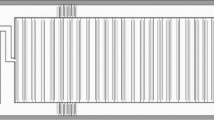Abstract
Future space-based far-infrared astrophysical observatories will require exquisitely sensitive detectors consistent with the low optical backgrounds. The PRobe far-Infrared Mission for Astrophysics (PRIMA) will deploy arrays of thousands of superconducting kinetic inductance detectors (KIDs) sensitive to radiation between 25 and 265 \(\mu\)m. Here, we present laboratory characterization of prototype, 25–80-\(\mu\)m wavelength, low-volume, aluminum KIDs designed for the low-background environment expected with PRIMA. A compact parallel plate capacitor is used to minimize the detector footprint and suppress TLS noise. A novel resonant absorber is designed to enhance response in the band of interest. We present noise and optical efficiency measurements of these detectors taken with a low-background cryostat and a cryogenic blackbody. A microlens-hybridized KID array is found to be photon noise limited down to about 50 aW with a limiting detector NEP of about \(6.5\times 10^{-19}~\text {W/Hz}^{1/2}\). A fit to an NEP model shows that our optical system is well characterized and understood down to 50 aW. We discuss future plans for low-volume aluminum KID array development as well as the testbeds used for these measurements.




Similar content being viewed by others
Notes
See https://prima.ipac.caltech.edu/ for more information on PRIMA.
References
J. Glenn, C. M. Bradford, E. Rosolowsky, R. Amini, K. Alatalo, L. Armus, A. J. Benson, T.-C. Chang, J. Darling, P. K. Day, J. L. Domber, D. Farrah, B. Hensley, S. J. Lipscy, B. D. Moore, S. Oliver, J. Perido, D. C. Redding, J. M. Rodgers, R. Shirley, H. A. Smith, J. B. Steeves, C. E. Tucker, J. Zmuidzinas. J. Astron. Telescopes Instruments Systems, 7, 3, 034004 (2021). https://doi.org/10.1117/1.JATIS.7.3.034004. Publisher: International Society for Optics and Photonics
Pathways to Discovery in Astronomy and Astrophysics for the 2020s. National Academies Press, Washington, D.C. (2021). ISBN 978-0-309-46734-6. https://doi.org/10.17226/26141
P.K. Day, H.G. LeDuc, B.A. Mazin, A. Vayonakis, J. Zmuidzinas, Nature 425(6960), 817–821 (2003). https://doi.org/10.1038/nature02037. Number: 6960 Publisher: Nature Publishing Group
J. Zmuidzinas, Ann. Rev. Condensed Matter Phys. 3(1), 169–214 (2012). https://doi.org/10.1146/annurev-conmatphys-020911-125022
S. Hailey-Dunsheath, R. M. J. Janssen, J. Glenn, C. M. Bradford, J. Perido, J. Redford, J. Zmuidzinas. J. Astronom. Telescopes Instruments Syst., 7, 1, 011015 (2021). https://doi.org/10.1117/1.JATIS.7.1.011015. Publisher: International Society for Optics and Photonics
E. Kane. J. Low Temp. Phys. This Special Issue (2023)
L. Foote. J. Low Temp. Phys. This Special Issue (2023)
N. F. Cothard, T. Stevenson, J. Mateo, N. Costen, K. Denis, J. Perido, I. Schrock, F. Wang, J. Glenn. Appl. Opt. Rev. (2023)
D.P. Pappas, M.R. Vissers, D.S. Wisbey, J.S. Kline, J. Gao, IEEE Trans. Appl. Superconduct. 21(3), 871–874 (2011). https://doi.org/10.1109/TASC.2010.2097578. Conference Name: IEEE Transactions on Applied Superconductivity
J. Baselmans, S. Yates, P. Diener, P. de Visser, J. Low Temperature Phys. 167(3), 360–366 (2012). https://doi.org/10.1007/s10909-012-0511-0
S.J.C. Yates, J.J.A. Baselmans, A. Endo, R.M.J. Janssen, L. Ferrari, P. Diener, A.M. Baryshev, Appl. Phys. Lett. 99(7), 073505 (2011). https://doi.org/10.1063/1.3624846
J. Hubmayr, J. Beall, D. Becker, H.-M. Cho, M. Devlin, B. Dober, C. Groppi, G.C. Hilton, K.D. Irwin, D. Li, P. Mauskopf, D.P. Pappas, J. Van Lanen, M.R. Vissers, Y. Wang, L.F. Wei, J. Gao, Appl. Phys. Lett. 106(7), 073505 (2015). https://doi.org/10.1063/1.4913418. Publisher: American Institute of Physics
Acknowledgements
Portions of this research were carried out at the Jet Propulsion Laboratory, California Institute of Technology, under a contract with NASA (80NM0018D0004). This work was also supported by internal research and development awards at NASA GSFC. NFC was supported by an NASA Postdoctoral Program Fellowship at NASA GSFC, administered by ORAU. JP was supported by a NASA Future Investigators in NASA Earth and Space Science and Technology Graduate Fellowship. The authors are grateful for the support of the NASA GSFC microlens fabrication and hybridization teams.
Author information
Authors and Affiliations
Contributions
N.F.C. prepared the figures, wrote the main manuscript text, and led the data analysis effort. P.K.D. designed the detectors. A.D.B. and H.L. fabricated the devices presented in the manuscript. C.A., B.H.E., L.F., S.H-D.,E.K., and P.K.D. performed the device measurements and contributed to the data analysis. J.P. and R.M.J. contributed to the data analysis and calibration. C.M.B., P.E., M.F., R.M.J., and J.G. contributed to the data analysis, discussion, and validation. All authors reviewed the manuscript.
Corresponding author
Ethics declarations
Conflict of interest
The authors declare no competing interests.
Additional information
Publisher's Note
Springer Nature remains neutral with regard to jurisdictional claims in published maps and institutional affiliations.
Rights and permissions
Springer Nature or its licensor (e.g. a society or other partner) holds exclusive rights to this article under a publishing agreement with the author(s) or other rightsholder(s); author self-archiving of the accepted manuscript version of this article is solely governed by the terms of such publishing agreement and applicable law.
About this article
Cite this article
Cothard, N.F., Albert, C., Beyer, A.D. et al. Parallel Plate Capacitor Aluminum KIDs for Future Far-Infrared Space-Based Observatories. J Low Temp Phys 214, 200–209 (2024). https://doi.org/10.1007/s10909-023-03039-0
Received:
Accepted:
Published:
Issue Date:
DOI: https://doi.org/10.1007/s10909-023-03039-0




